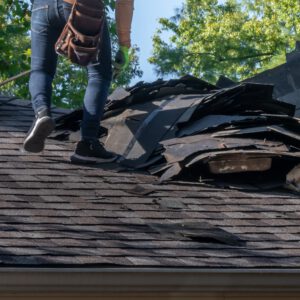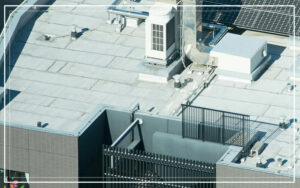Roofs are subject to a lot of wear and tear. From high winds to flying twigs and snow buildup, they need to be well-maintained to protect your home and prevent costly leaks.

If your current roof is old and damaged, it may be time to consider Roof Replacement NJ. But is it the right option for you?
Many homeowners choose to have their roof replaced for a variety of reasons. It can be a way to boost the resale value of their home, reduce energy bills, or keep their family safe from mold and mildew caused by leaks. No matter the reason, a roof replacement requires the right materials in order to be successful.
When choosing the type of roofing material for your roof, there are several options to consider including asphalt shingles, metal shingle or tiles and wood shakes. The choice of material depends on the local climate and the preferred home style. Metal roofs are a popular choice in some areas due to their fire resistance while clay or slate tiles are often more common in other regions. Wood shakes or shingles are more expensive but offer a classic appearance while composition shingle roofs have gained in popularity as they provide an attractive alternative to traditional asphalt shingles.
The decking of a roof is called sheathing and is the wooden foundation layer where shingles and other roof coverings are attached to your home. During a roof replacement or repair project, contractors will inspect the sheathing to see if any soft spots or wood rot exist. If necessary, sheathing can be replaced with new plywood or oriented strand board (OSB).
Another important roofing material is underlayment. This is a waterproof membrane that goes over the decking and shingles. It helps prevent water from leaking into the attic and protects against ice damming. Underlayment can be purchased as rolls of synthetic or rubber underlayment or in sheets of fiberglass or ethylene propylene diene terpolymer (EPDM).
In addition to these major roofing materials, a few other roofing materials are needed for the job. Flashing is used at areas of the roof such as the chimney, valleys and where two incline planes meet. This is usually some form of metal and is a critical part of the overall roofing system.
Other important roofing materials are roof vents, drip edge and fascia boards. These are important components of the attic ventilation system that is required to help prevent overheating and moisture build-up.
Installation
The roof is one of the most important parts of a home. It protects a family during storms and keeps their house a comfortable temperature year-round. If it becomes damaged or worn, a replacement is needed. Roof replacement can be a long process, but with the right contractor and a little planning, it can go smoothly.
Before any work starts, your roofing contractor will make sure that the area around your home is clear of vehicles, outdoor furniture, and anything else that could be damaged during the installation. This is to prevent any accidents or injuries while they are working on your roof.
Next, they will start the roof replacement process by tearing off your old roof to expose the decking. They may also do minor repairs to sheathing, rafters, and trusses if necessary. Depending on the material, this step can take a few days or longer.
After removing the existing roof, your contractor will set up protection to keep everything clean and safe. This includes covering the driveway and walkways with tarps, moving cars out of the garage, and covering any items in your yard that could get dirty or damaged during the work.
Once the roof is cleared, they can begin to install your new roof. They will start at the eaves and metal drip edge, then work their way up to the peak. They will add flashing and ice and water sheathing as needed, as well as any vents, wood stove pipes, or chimneys.
Finally, they will install the shingles or roof tiles. They will use a shingle nailer to ensure that the shingles are placed correctly and have proper coverage. They will also use roofing cement to seal the shingle edges and seams.
Depending on your chosen roofing materials, you might need to add more ventilation to your attic. This will help lower your energy bill and improve the life of your new roof. Your contractor will probably recommend adding more vent holes or installing ridge vents for maximum airflow and heat exchange. They will also install a new gable end vent to prevent moisture from entering the attic.
Repairs
Your roof protects the rest of your home from rain, wind and sun damage. However, it is exposed to the elements for many years and will eventually start showing wear and tear. If you notice cracked or missing shingles, or if you are experiencing leaking, it may be time to consider a roof replacement.
Repairs usually include fixing components like pipe boots, flashing, vents and more that are causing leaks or other problems. They can also include repairing areas of the roof that are exposed to the elements and may have suffered from erosion over the years.
The cost of a roof repair will depend on the scope of work required, the material used, and whether special features are involved. For example, skylights, dormer windows and chimneys require additional flashing and specially measured roofing materials that will add to the overall price of the job.
In addition to these special features, the pitch or design of your roof can impact the price of a repair or replacement as well. Steep roofs are more difficult to work on and therefore tend to be more expensive than flat or low-pitched roofs.
It is also important to take into account whether you will be able to use insurance on your new roof as this can affect the final price of the job. Generally, insurance is only available if a weather-related event caused the damage, so it is important to contact your insurance company and assess the situation before proceeding with a roof replacement or repair.
When it comes to repairing or replacing your roof, it is a good idea to consult with an expert. They can advise you on the best option for your home and budget. Using an expert will help ensure you have peace of mind and confidence in the quality of your roof.
If you are having your roof repaired or replaced, it is a good idea to move any indoor furniture or other items that could be damaged by hammers or debris. You will also want to bring pets inside to prevent them from being frightened by the noise and possible dangers of a reroofing project.
Maintenance
Roofing materials are designed to withstand the elements, but wear and tear over time can cause damage. Regular inspections can help identify signs of problems and allow repairs to be made before major damage occurs.
If your roof has sustained a significant amount of damage, it may be time for replacement. This will involve tearing out the existing roof materials and installing new ones. A qualified roofing contractor can inspect the existing roof and provide advice on whether a full replacement is required.
It’s also important to check indoors for signs of water damage. This can include mold, mildew and peeling paint. It’s also a good idea to check the trusses and beams in your building for signs of structural stress.
Roof inspections should be conducted on a regular basis, preferably on a biannual basis. During an inspection, the roof should be walked and a written report with observations and recommendations should be provided to management. Building personnel should be trained to walk the roof safely, using walkway pads or roof pavers where possible.
A detailed inspection should be made of the flashings, as the majority of leaks occur at these points. It’s especially important to check the flashings around pipes, vents and equipment curbs, where the flashing is often stressed more than the roof field by thermal movement, differential movement and UV degradation.
Other areas of the roof that should be inspected include:
Fascia and soffits: The fascia runs along the underside of the roof’s overhang. It supports gutters and is necessary for ventilation. It’s important that the soffits and fascia are in good condition, as they are the first line of defense against water penetration.
Holes: The smallest holes can be repaired with patching material that is compatible with your roof type. However, if many holes are present, it’s likely that the entire roof will need to be replaced.
If your commercial roof is over 20 years old and has substantial damage, it’s probably time to consider a full replacement. In addition to replacing the shingles and other roof components, a full replacement will also allow for the installation of a new waterproof membrane.

